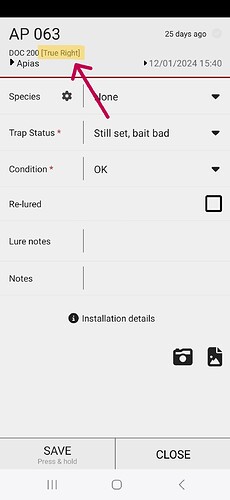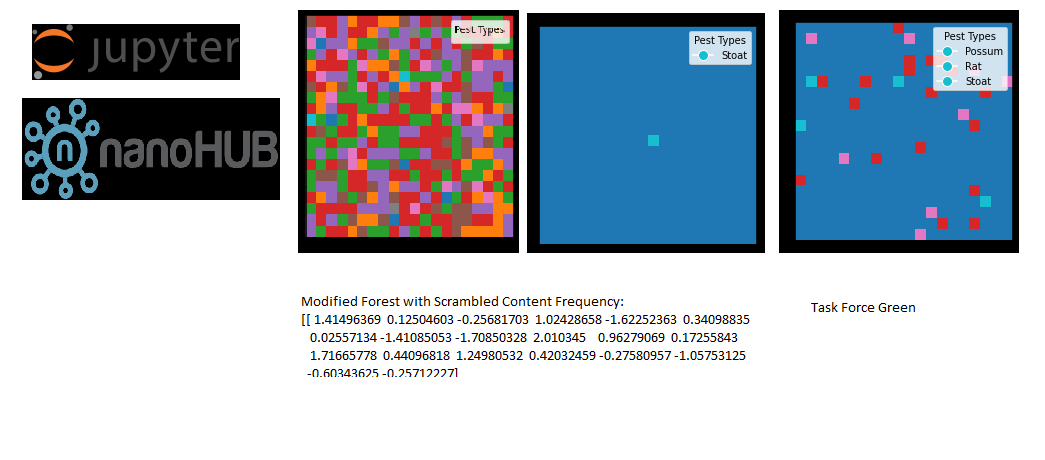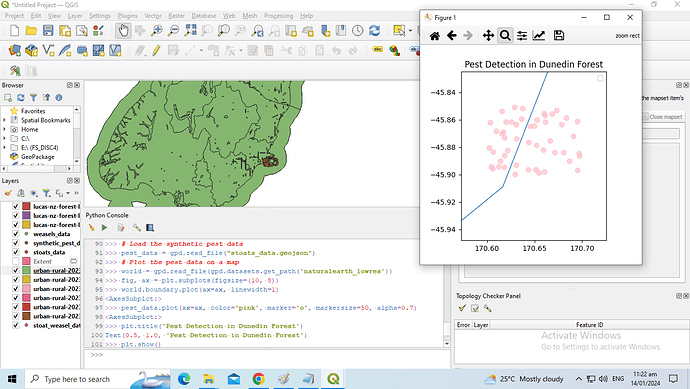import numpy as np
import matplotlib.pyplot as plt
def create_forest(rows, cols, pest_ratios):
“”“Create a forest with pests based on specified ratios.”“”
forest = np.zeros((rows, cols))
total_cells = rows * cols
for pest_type, ratio in pest_ratios.items():
num_pests = int(total_cells * ratio)
pest_locations = np.random.choice(total_cells, num_pests, replace=False)
for loc in pest_locations:
row, col = divmod(loc, cols)
forest[row, col] = pest_type
return forest
def highlight_trap(ax, trap_loc, trap_size):
“”“Highlight a trap on the plot.”“”
trap_row, trap_col = trap_loc
trap_range = trap_size // 2
rect = plt.Rectangle((trap_col - trap_range - 0.5, trap_row - trap_range - 0.5),
trap_size, trap_size, linewidth=2, edgecolor=‘red’, facecolor=‘none’)
ax.add_patch(rect)
def draw_best_trap(ax, trap_loc, trap_size):
“”“Draw the best trap.”“”
trap_row, trap_col = trap_loc
trap_size_half = trap_size // 2
for row in range(trap_row - trap_size_half, trap_row + trap_size_half + 1):
for col in range(trap_col - trap_size_half, trap_col + trap_size_half + 1):
if 0 <= row < forest.shape[0] and 0 <= col < forest.shape[1]:
ax.text(col, row, 'X', color='red', fontsize=12, ha='center', va='center', fontweight='bold')
else:
print(' ', end='')
print()
def plot_forest(ax, forest, trap_locations, trap_size, caught_pests=None, title=‘Forest Scenario’, cmap=‘tab10’, geofence_radius=3):
“”“Plot the forest using Matplotlib.”“”
ax.imshow(forest, cmap=cmap, interpolation=‘nearest’)
ax.set_title(title)
ax.set_xlabel(‘Columns’)
ax.set_ylabel(‘Rows’)
# Add legend
legend_labels = {1: 'Possum', 2: 'Rat', 3: 'Stoat'}
legend_elements = {i: plt.Line2D([0], [0], marker='o', color='w', markerfacecolor=plt.cm.tab10(i),
markersize=10, label=legend_labels[i]) for i in legend_labels.keys()}
ax.legend(handles=legend_elements.values(), title='Pest Types')
# Highlight traps
for trap_loc in trap_locations:
highlight_trap(ax, trap_loc, trap_size)
# Highlight caught pests
if caught_pests is not None:
for row in range(forest.shape[0]):
for col in range(forest.shape[1]):
if caught_pests[row, col] == 1: # Caught possum
ax.text(col, row, 'X', color='blue', fontsize=12, ha='center', va='center', rotation=45)
elif caught_pests[row, col] == 2: # Caught rat
ax.text(col, row, 'X', color='green', fontsize=12, ha='center', va='center', rotation=-45)
elif caught_pests[row, col] == 3: # Caught stoat
ax.text(col, row, 'X', color='purple', fontsize=12, ha='center', va='center')
# Add geofence around the area with false traps
for trap_loc in trap_locations:
geofence_circle = plt.Circle((trap_loc[1], trap_loc[0]), geofence_radius, fill=False, edgecolor='orange', linestyle='dashed')
ax.add_patch(geofence_circle)
# Draw the trap
for trap_loc in trap_locations:
draw_best_trap(ax, trap_loc, trap_size)
Set simulation parameters
rows, cols = 20, 20
pest_ratios = {1: 0.05, 2: 0.02, 3: 0.01} # 1: Possum, 2: Rat, 3: Stoat
trap_size = 5
radam_freq = 0.8 # Probability of trapping with random frequency (adjust as needed)
Create the initial forest based on specified ratios
initial_forest = create_forest(rows, cols, pest_ratios)
Set trap locations for different views
trap_locations_1 = [(5, 5), (15, 15)]
trap_locations_2 = [(10, 5), (5, 15)]
trap_locations_3 = [(15, 5), (10, 15)]
Plot different views
fig, axes = plt.subplots(nrows=2, ncols=2, figsize=(12, 12))
Initial view
plot_forest(axes[0, 0], initial_forest, trap_locations=[], trap_size=trap_size, title=‘Initial Forest Scenario’)
View 1
caught_pests_1 = catch_pests(initial_forest, trap_locations_1, trap_size, radam_freq)
plot_forest(axes[0, 1], initial_forest, trap_locations_1, trap_size, caught_pests_1, title=‘View 1’)
View 2
caught_pests_2 = catch_pests(initial_forest, trap_locations_2, trap_size, radam_freq)
plot_forest(axes[1, 0], initial_forest, trap_locations_2, trap_size, caught_pests_2, title=‘View 2’)
View 3
caught_pests_3 = catch_pests(initial_forest, trap_locations_3, trap_size, radam_freq)
plot_forest(axes[1, 1], initial_forest, trap_locations_3, trap_size, caught_pests_3, title=‘View 3’)
Draw the trap next to each subplot
for i, ax in enumerate(axes.flat):
trap_loc = trap_locations_1[i]
draw_best_trap(ax, trap_loc, trap_size)
plt.tight_layout()
plt.show()


